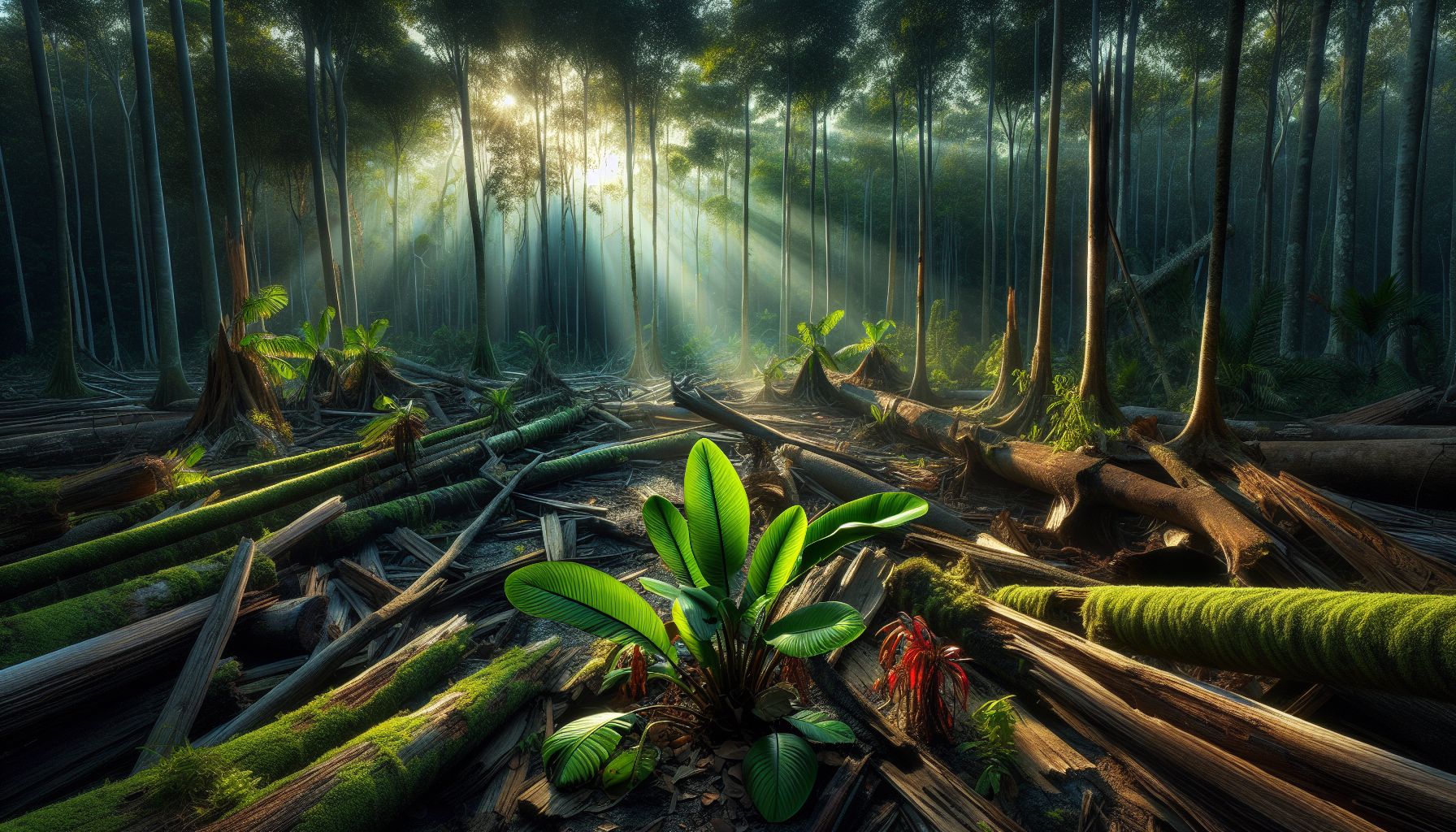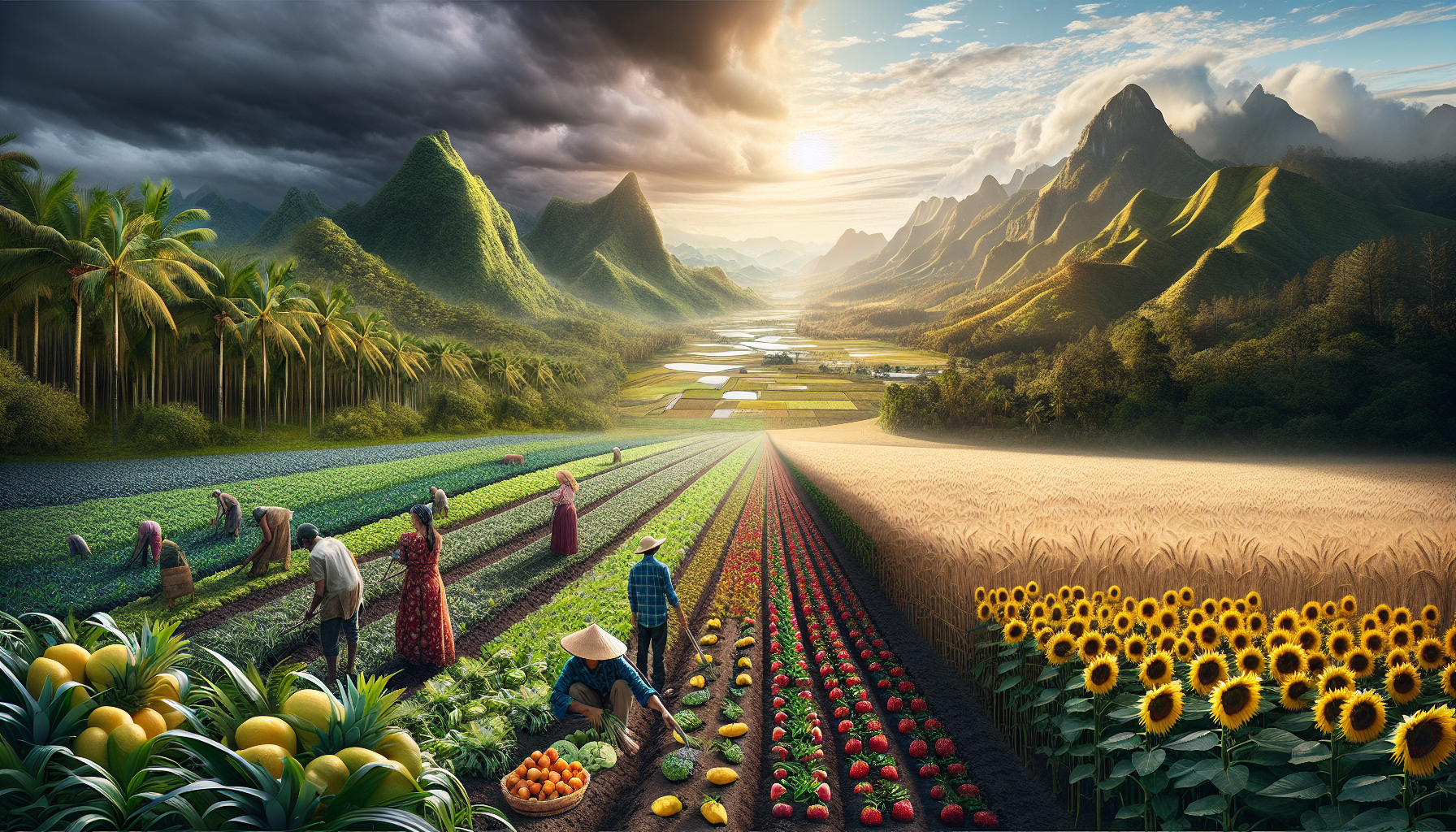In the hushed whispers of the world’s forests, a silent crisis unfolds—one that threatens the very essence of biodiversity on our planet. While the majestic silhouettes of endangered animals often capture our attention and dominate the narrative of conservation, there exists a quieter, yet equally profound tragedy transpiring in the shadows. This is the story of rare plant species, the unsung heroes of our ecosystems, whose survival is imperiled by the relentless advance of deforestation. As the chainsaws echo through ancient woodlands and fires ravage green expanses, these silent victims, crucial to the intricate tapestry of life, stand on the brink of oblivion.
Forests are more than just a collection of trees; they are the lifeblood of our planet, home to an estimated 80% of the world’s terrestrial biodiversity. Within these vibrant ecosystems, rare plant species perform roles of monumental importance. From acting as carbon sinks that mitigate climate change to housing medicinal potentials that might hold the keys to future cures, these plants are indispensable. Yet, as the global appetite for land, timber, and agriculture grows insatiable, forests are being decimated at an alarming rate, leading to the fragmentation and loss of habitats for countless plant species. The result? An irreplaceable loss of genetic diversity and a destabilization of ecosystems.
As we delve deeper into this article, we will unravel the multifaceted impact of deforestation on rare plant species. We will explore the causes driving this rampant deforestation, examining the roles played by agriculture, urban expansion, and illegal logging. Moreover, we will highlight the intricate ways in which these plants contribute to their ecosystems, not only supporting wildlife but also providing ecological services that humans often take for granted. Their disappearance could lead to cascading effects that may ultimately disrupt ecological balance and human livelihoods alike.
The narrative of deforestation is not solely one of loss and destruction; it is also a call to action, a plea for awareness and change. This article will present inspiring stories of resilience and conservation efforts that are making a difference. From grassroots initiatives to international policies, we will showcase how communities, scientists, and policymakers are coming together to combat deforestation and protect these botanical treasures. Highlighting these efforts underscores the importance of collective responsibility in preserving our planet’s natural heritage for future generations.
Join us on this journey through the forgotten forests of the world, where each rare plant tells a story of survival and struggle. Let us shine a light on the silent victims of deforestation, amplifying their voices and understanding their significance in the grand scheme of nature. In doing so, we can begin to appreciate the urgent need to protect these vital species and their habitats, ensuring that the forests continue to thrive as sanctuaries of biodiversity and life. 🌿
The Alarming Scope of Deforestation
Deforestation is an alarming environmental issue that has been occurring for centuries but has accelerated in recent decades. The main drivers of deforestation include agriculture, logging, infrastructure development, and urban expansion. This relentless clearing of forests not only contributes to climate change by releasing stored carbon dioxide but also endangers countless species, many of which are already at risk of extinction.
Forests are home to over 80% of terrestrial biodiversity, housing countless plant and animal species that are yet to be studied. However, as deforestation continues, these rich ecosystems are being destroyed, leading to the loss of rare plant species that are silent victims of these destructive activities. These rare plants are not just important for biodiversity; they also have potential medicinal and ecological value that we are losing without even fully understanding.
The impact of deforestation is not uniform across the globe. Certain regions are more vulnerable due to their high biodiversity and the presence of numerous endemic species. The Amazon rainforest, the Congo Basin, and Southeast Asian forests are some of the most critical hotspots where deforestation has severe implications. These regions not only harbor rare plant species but also play a crucial role in global ecological balance.
Deforestation Rates and Their Consequences
Recent data shows that deforestation rates are increasing in various parts of the world. According to the Global Forest Watch, the world lost a staggering amount of forest cover in 2020 alone, with Brazil, the Democratic Republic of Congo, and Indonesia topping the list of countries with the highest deforestation rates. The consequences of these actions are far-reaching, affecting local climates, water cycles, and wildlife habitats.
Rare plant species, which often require specific conditions to thrive, are particularly vulnerable. As their habitats shrink, they face increased competition for resources, reduced genetic diversity, and a higher likelihood of extinction. This loss of plant species can lead to a cascade of effects throughout the ecosystem, affecting everything from soil health to pollinator populations.
For a better understanding, take a look at the table below, which compares the deforestation rates and the number of rare plant species affected in different regions:
| Region | Deforestation Rate (hectares/year) | Rare Plant Species Affected |
|---|---|---|
| Amazon Rainforest | 1,300,000 | Approximately 10,000 |
| Congo Basin | 500,000 | Over 6,000 |
| Southeast Asia | 250,000 | More than 5,000 |
The Ecological Importance of Rare Plant Species
Rare plant species play a significant role in maintaining ecological balance. They often serve as keystone species, meaning their presence is crucial for the health and stability of their ecosystems. These plants can contribute to nutrient cycling, soil formation, and the provision of habitat and food for various animal species.
In addition, rare plants have potential medicinal properties that are not fully explored. Many pharmaceuticals are derived from plant compounds, and the loss of rare plants due to deforestation could mean the loss of future medical breakthroughs. Traditional knowledge systems, particularly those of indigenous peoples, hold valuable insights into the uses of these plants for health and healing.
The table below illustrates the potential medicinal uses of some rare plant species and their current status:
| Rare Plant Species | Potential Medicinal Use | Conservation Status |
|---|---|---|
| Yew Tree (Taxus spp.) | Cancer treatment (Taxol) | Endangered |
| Rosy Periwinkle (Catharanthus roseus) | Leukemia and Hodgkin’s lymphoma | Critically Endangered |
| Jaborandi (Pilocarpus spp.) | Glaucoma treatment | Vulnerable |
Conservation Efforts and Challenges
Despite the dire situation, various conservation efforts are underway to protect rare plant species from deforestation. Protected areas, sustainable forestry practices, and reforestation projects are some of the measures being implemented to curb forest loss. However, these efforts face numerous challenges, including insufficient funding, lack of political will, and competing land-use priorities.
International collaborations and policy frameworks, such as the Convention on Biological Diversity, aim to address these issues by promoting sustainable practices and enhancing biodiversity conservation. However, the effectiveness of these policies largely depends on the commitment of individual countries and the integration of local communities into conservation efforts.
To further understand the importance of conserving rare plant species, watch this insightful video from the YouTube channel “Nature’s Guardians”: [Link to video]
Conclusion: Moving Forward
Addressing deforestation and its impact on rare plant species requires a multifaceted approach that involves global cooperation, local community engagement, and innovative conservation strategies. While the challenges are significant, the potential benefits of preserving these silent victims are immense, offering ecological, medicinal, and cultural value.
By fostering awareness and taking action, we can ensure that future generations inherit a planet rich in biodiversity and ecological health. Consider supporting conservation initiatives, spreading awareness, and advocating for policies that protect our planet’s vital resources.

Conclusion
In conclusion, the article “Silent Victims: The Devastating Impact of Deforestation on Rare Plant Species” sheds light on a pressing environmental issue that often goes unnoticed amidst broader conversations on climate change and biodiversity loss. Throughout this discussion, we delved into the alarming rate at which deforestation is occurring globally and its specific impact on rare and endangered plant species. 🌿
Firstly, we explored how deforestation directly results in the loss of habitat for countless plant species, many of which are endemic to specific regions and cannot survive outside their native environments. The clearing of forests for agriculture, urban development, and logging disrupts these delicate ecosystems, pushing many rare plants to the brink of extinction. Furthermore, we addressed the indirect effects of deforestation, such as changes in local climate conditions and soil composition, which further threaten these species’ survival.
Secondly, we highlighted the interconnectedness of ecosystems and how the loss of plant biodiversity can have cascading effects on wildlife, human communities, and global ecological health. Plants play critical roles in carbon sequestration, water regulation, and providing habitats and food sources for various animal species. The disappearance of rare plants not only destabilizes these functions but also diminishes the genetic diversity necessary for ecosystems to adapt to environmental changes.
The article also emphasized the socio-economic impacts of deforestation, particularly on indigenous and local communities who rely on forest resources for their livelihoods and cultural practices. These communities often serve as stewards of biodiversity, possessing invaluable traditional knowledge about plant species and their uses. The loss of rare plants, therefore, also signifies a loss of cultural heritage and knowledge.
To reinforce the importance of this topic, we must recognize that preserving plant biodiversity is not just an environmental imperative but a necessity for ensuring the resilience of our planet’s ecosystems. Every plant species plays a unique role in its environment, and the loss of any one species can have unforeseen consequences on ecological balance and human well-being.
The urgency to address deforestation and its impact on rare plant species cannot be overstated. It requires concerted efforts from governments, NGOs, scientists, and individuals to implement sustainable practices, enforce conservation laws, and support reforestation projects. Additionally, increasing public awareness and education about the importance of plant biodiversity is crucial for garnering the collective action needed to protect our natural heritage.
As readers, you have the power to make a difference. Whether it’s by supporting conservation organizations, advocating for sustainable policies, or simply sharing this knowledge with others, every action counts. We encourage you to reflect on the information presented and consider how you can contribute to preserving the invaluable biodiversity of our planet. 🌎
Please feel free to share your thoughts in the comments section below, or engage with others who are passionate about environmental conservation. By sharing this article, you can help spread awareness and inspire action among your network.
For further reading and to stay informed about ongoing conservation efforts, you can visit reputable sources such as the World Wildlife Fund (WWF) at [worldwildlife.org](https://www.worldwildlife.org/) and the International Union for Conservation of Nature (IUCN) at [iucn.org](https://www.iucn.org/). These organizations provide up-to-date information and resources on biodiversity and conservation initiatives.
Together, we can work towards a future where rare plant species are not just a memory of the past but a vibrant and integral part of our planet’s living tapestry. Let us stand united in our commitment to safeguarding the silent victims of deforestation and ensuring a sustainable world for generations to come. 🌱
Toni Santos is a visual storyteller and botanical artisan whose creations explore the wild elegance of carnivorous and exotic plants. With a deep reverence for nature’s most mysterious flora, Toni captures the untamed beauty of insect-eating mechanisms, alien-like blooms, and resilient life thriving in extreme environments.
Rooted in a lifelong fascination with the strange intelligence of plants, his work blends science, symbolism, and storytelling. From the snap of a Venus flytrap to the labyrinthine curves of a Nepenthes pitcher, each piece Toni creates reveals a deeper narrative — one of survival, adaptation, and the subtle power of nature’s most unexpected designs.
With a background in visual design and handcrafted artistry, Toni merges technique with intention, crafting illustrations, collections, and visual studies that not only depict these botanical wonders — but evoke their hidden magic. His inspiration often comes from ancient lore, natural history, and the eerie elegance of ecosystems where these plants thrive.
As the creative force behind Vizovex, Toni shares this botanical fascination with the world, offering curated artwork, stories, and pieces that help others reconnect with nature’s wilder, more enigmatic side.
His work is a tribute to:
The fierce beauty of carnivorous plants
The visual language of adaptation and survival
The mysteries of exotic flora in forgotten habitats
Whether you’re a plant enthusiast, a science lover, or someone drawn to the strange and beautiful, Toni welcomes you into a world where every leaf hides a secret — one trap, one tendril, one story at a time.




